Bullying in Nursing
VerifiedAdded on 2020/12/10
|10
|3325
|87
Essay
AI Summary
This essay examines the problem of bullying in nursing and proposes a change management strategy based on Rogers' Diffusion of Innovation Theory to address this issue. It analyzes the impact of bullying on nurses' well-being and patient safety, and explores the five stages of innovation adoption and different adopter categories to create a positive and safe work environment for nurses.
Contribute Materials
Your contribution can guide someone’s learning journey. Share your
documents today.

APPLYING EVIDENCE TO
PRACTICE
Sample Project
ASSESSMENT 2
TRANSLATING EVIDENCE
TO PRACTICE
PRACTICE
Sample Project
ASSESSMENT 2
TRANSLATING EVIDENCE
TO PRACTICE
Secure Best Marks with AI Grader
Need help grading? Try our AI Grader for instant feedback on your assignments.
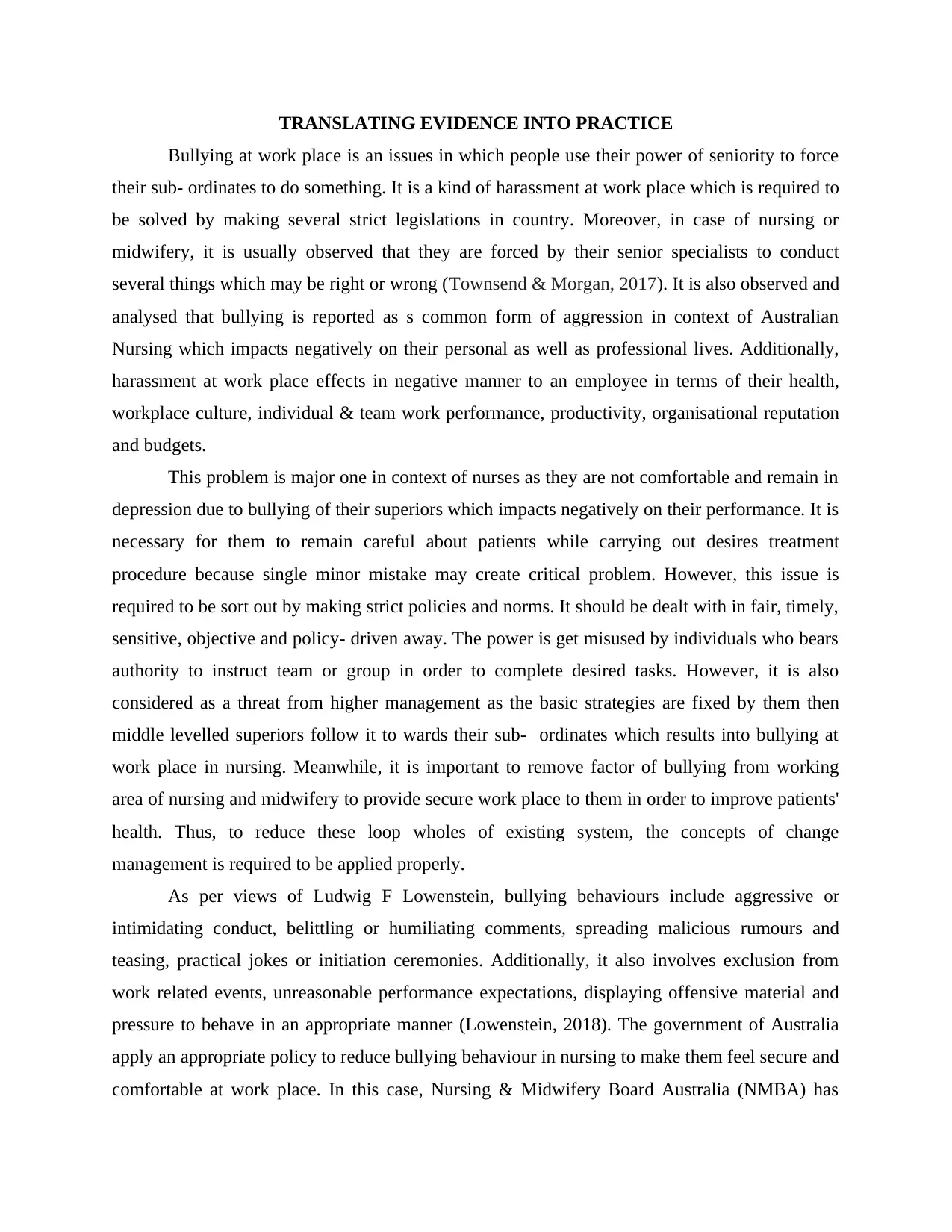
TRANSLATING EVIDENCE INTO PRACTICE
Bullying at work place is an issues in which people use their power of seniority to force
their sub- ordinates to do something. It is a kind of harassment at work place which is required to
be solved by making several strict legislations in country. Moreover, in case of nursing or
midwifery, it is usually observed that they are forced by their senior specialists to conduct
several things which may be right or wrong (Townsend & Morgan, 2017). It is also observed and
analysed that bullying is reported as s common form of aggression in context of Australian
Nursing which impacts negatively on their personal as well as professional lives. Additionally,
harassment at work place effects in negative manner to an employee in terms of their health,
workplace culture, individual & team work performance, productivity, organisational reputation
and budgets.
This problem is major one in context of nurses as they are not comfortable and remain in
depression due to bullying of their superiors which impacts negatively on their performance. It is
necessary for them to remain careful about patients while carrying out desires treatment
procedure because single minor mistake may create critical problem. However, this issue is
required to be sort out by making strict policies and norms. It should be dealt with in fair, timely,
sensitive, objective and policy- driven away. The power is get misused by individuals who bears
authority to instruct team or group in order to complete desired tasks. However, it is also
considered as a threat from higher management as the basic strategies are fixed by them then
middle levelled superiors follow it to wards their sub- ordinates which results into bullying at
work place in nursing. Meanwhile, it is important to remove factor of bullying from working
area of nursing and midwifery to provide secure work place to them in order to improve patients'
health. Thus, to reduce these loop wholes of existing system, the concepts of change
management is required to be applied properly.
As per views of Ludwig F Lowenstein, bullying behaviours include aggressive or
intimidating conduct, belittling or humiliating comments, spreading malicious rumours and
teasing, practical jokes or initiation ceremonies. Additionally, it also involves exclusion from
work related events, unreasonable performance expectations, displaying offensive material and
pressure to behave in an appropriate manner (Lowenstein, 2018). The government of Australia
apply an appropriate policy to reduce bullying behaviour in nursing to make them feel secure and
comfortable at work place. In this case, Nursing & Midwifery Board Australia (NMBA) has
Bullying at work place is an issues in which people use their power of seniority to force
their sub- ordinates to do something. It is a kind of harassment at work place which is required to
be solved by making several strict legislations in country. Moreover, in case of nursing or
midwifery, it is usually observed that they are forced by their senior specialists to conduct
several things which may be right or wrong (Townsend & Morgan, 2017). It is also observed and
analysed that bullying is reported as s common form of aggression in context of Australian
Nursing which impacts negatively on their personal as well as professional lives. Additionally,
harassment at work place effects in negative manner to an employee in terms of their health,
workplace culture, individual & team work performance, productivity, organisational reputation
and budgets.
This problem is major one in context of nurses as they are not comfortable and remain in
depression due to bullying of their superiors which impacts negatively on their performance. It is
necessary for them to remain careful about patients while carrying out desires treatment
procedure because single minor mistake may create critical problem. However, this issue is
required to be sort out by making strict policies and norms. It should be dealt with in fair, timely,
sensitive, objective and policy- driven away. The power is get misused by individuals who bears
authority to instruct team or group in order to complete desired tasks. However, it is also
considered as a threat from higher management as the basic strategies are fixed by them then
middle levelled superiors follow it to wards their sub- ordinates which results into bullying at
work place in nursing. Meanwhile, it is important to remove factor of bullying from working
area of nursing and midwifery to provide secure work place to them in order to improve patients'
health. Thus, to reduce these loop wholes of existing system, the concepts of change
management is required to be applied properly.
As per views of Ludwig F Lowenstein, bullying behaviours include aggressive or
intimidating conduct, belittling or humiliating comments, spreading malicious rumours and
teasing, practical jokes or initiation ceremonies. Additionally, it also involves exclusion from
work related events, unreasonable performance expectations, displaying offensive material and
pressure to behave in an appropriate manner (Lowenstein, 2018). The government of Australia
apply an appropriate policy to reduce bullying behaviour in nursing to make them feel secure and
comfortable at work place. In this case, Nursing & Midwifery Board Australia (NMBA) has
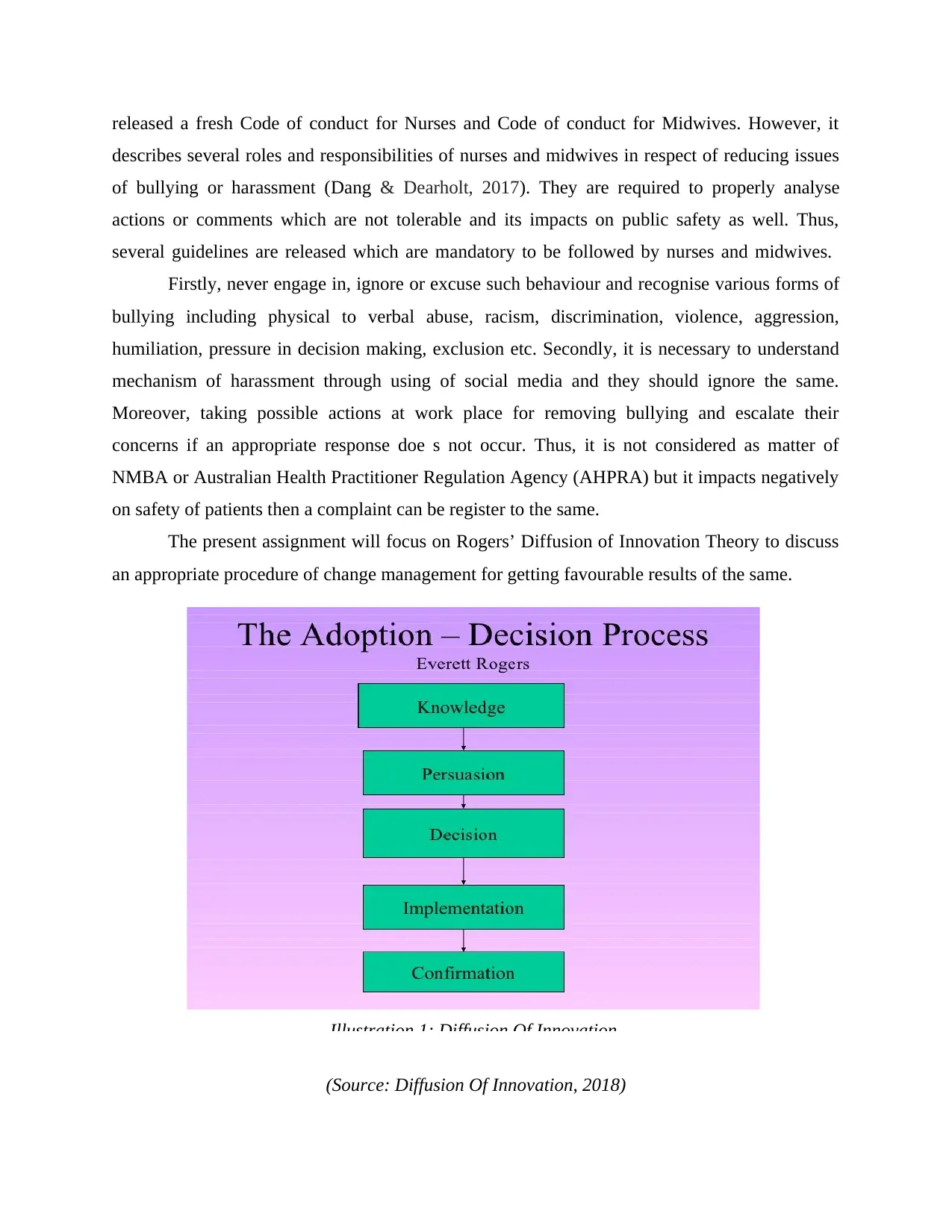
released a fresh Code of conduct for Nurses and Code of conduct for Midwives. However, it
describes several roles and responsibilities of nurses and midwives in respect of reducing issues
of bullying or harassment (Dang & Dearholt, 2017). They are required to properly analyse
actions or comments which are not tolerable and its impacts on public safety as well. Thus,
several guidelines are released which are mandatory to be followed by nurses and midwives.
Firstly, never engage in, ignore or excuse such behaviour and recognise various forms of
bullying including physical to verbal abuse, racism, discrimination, violence, aggression,
humiliation, pressure in decision making, exclusion etc. Secondly, it is necessary to understand
mechanism of harassment through using of social media and they should ignore the same.
Moreover, taking possible actions at work place for removing bullying and escalate their
concerns if an appropriate response doe s not occur. Thus, it is not considered as matter of
NMBA or Australian Health Practitioner Regulation Agency (AHPRA) but it impacts negatively
on safety of patients then a complaint can be register to the same.
The present assignment will focus on Rogers’ Diffusion of Innovation Theory to discuss
an appropriate procedure of change management for getting favourable results of the same.
(Source: Diffusion Of Innovation, 2018)
Illustration 1: Diffusion Of Innovation
describes several roles and responsibilities of nurses and midwives in respect of reducing issues
of bullying or harassment (Dang & Dearholt, 2017). They are required to properly analyse
actions or comments which are not tolerable and its impacts on public safety as well. Thus,
several guidelines are released which are mandatory to be followed by nurses and midwives.
Firstly, never engage in, ignore or excuse such behaviour and recognise various forms of
bullying including physical to verbal abuse, racism, discrimination, violence, aggression,
humiliation, pressure in decision making, exclusion etc. Secondly, it is necessary to understand
mechanism of harassment through using of social media and they should ignore the same.
Moreover, taking possible actions at work place for removing bullying and escalate their
concerns if an appropriate response doe s not occur. Thus, it is not considered as matter of
NMBA or Australian Health Practitioner Regulation Agency (AHPRA) but it impacts negatively
on safety of patients then a complaint can be register to the same.
The present assignment will focus on Rogers’ Diffusion of Innovation Theory to discuss
an appropriate procedure of change management for getting favourable results of the same.
(Source: Diffusion Of Innovation, 2018)
Illustration 1: Diffusion Of Innovation
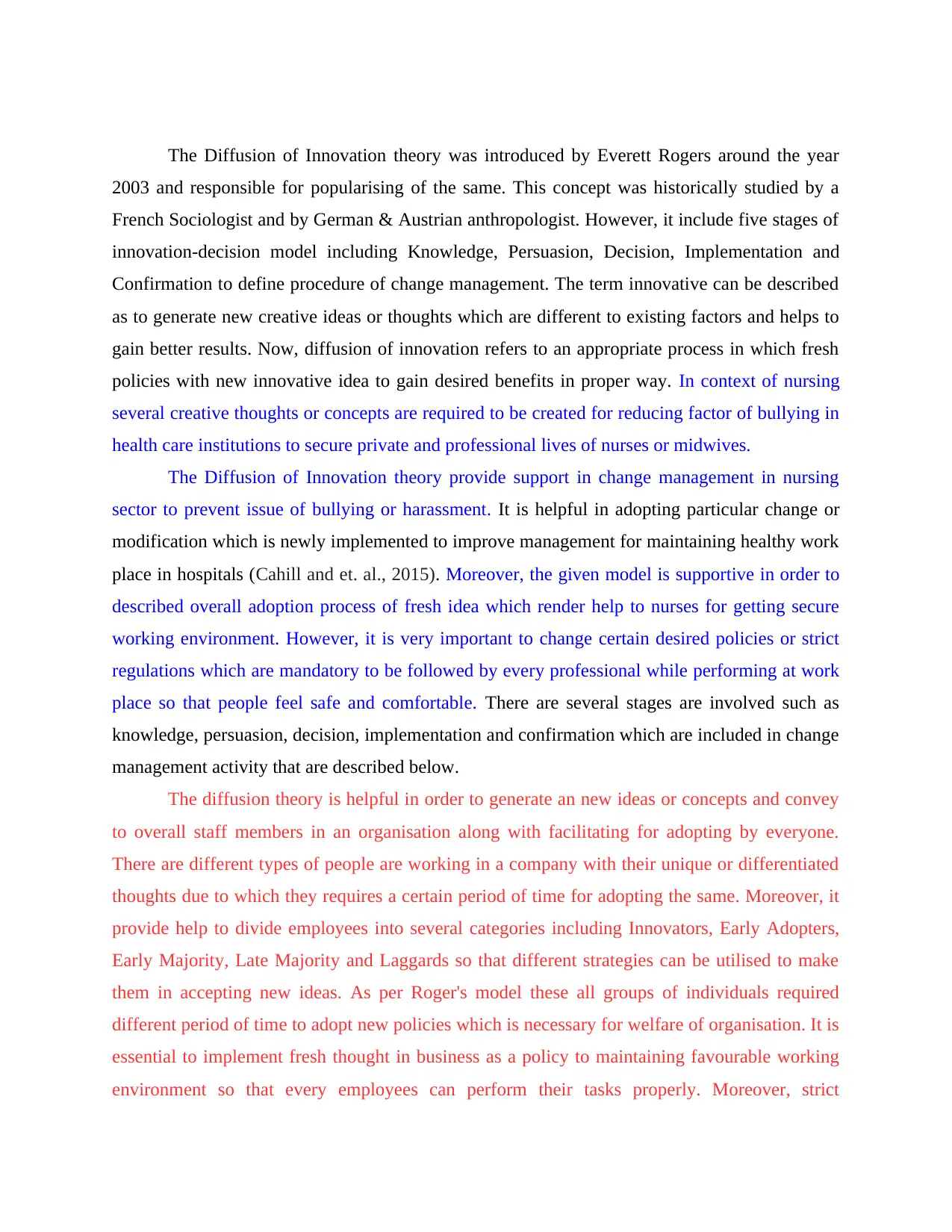
The Diffusion of Innovation theory was introduced by Everett Rogers around the year
2003 and responsible for popularising of the same. This concept was historically studied by a
French Sociologist and by German & Austrian anthropologist. However, it include five stages of
innovation‐decision model including Knowledge, Persuasion, Decision, Implementation and
Confirmation to define procedure of change management. The term innovative can be described
as to generate new creative ideas or thoughts which are different to existing factors and helps to
gain better results. Now, diffusion of innovation refers to an appropriate process in which fresh
policies with new innovative idea to gain desired benefits in proper way. In context of nursing
several creative thoughts or concepts are required to be created for reducing factor of bullying in
health care institutions to secure private and professional lives of nurses or midwives.
The Diffusion of Innovation theory provide support in change management in nursing
sector to prevent issue of bullying or harassment. It is helpful in adopting particular change or
modification which is newly implemented to improve management for maintaining healthy work
place in hospitals (Cahill and et. al., 2015). Moreover, the given model is supportive in order to
described overall adoption process of fresh idea which render help to nurses for getting secure
working environment. However, it is very important to change certain desired policies or strict
regulations which are mandatory to be followed by every professional while performing at work
place so that people feel safe and comfortable. There are several stages are involved such as
knowledge, persuasion, decision, implementation and confirmation which are included in change
management activity that are described below.
The diffusion theory is helpful in order to generate an new ideas or concepts and convey
to overall staff members in an organisation along with facilitating for adopting by everyone.
There are different types of people are working in a company with their unique or differentiated
thoughts due to which they requires a certain period of time for adopting the same. Moreover, it
provide help to divide employees into several categories including Innovators, Early Adopters,
Early Majority, Late Majority and Laggards so that different strategies can be utilised to make
them in accepting new ideas. As per Roger's model these all groups of individuals required
different period of time to adopt new policies which is necessary for welfare of organisation. It is
essential to implement fresh thought in business as a policy to maintaining favourable working
environment so that every employees can perform their tasks properly. Moreover, strict
2003 and responsible for popularising of the same. This concept was historically studied by a
French Sociologist and by German & Austrian anthropologist. However, it include five stages of
innovation‐decision model including Knowledge, Persuasion, Decision, Implementation and
Confirmation to define procedure of change management. The term innovative can be described
as to generate new creative ideas or thoughts which are different to existing factors and helps to
gain better results. Now, diffusion of innovation refers to an appropriate process in which fresh
policies with new innovative idea to gain desired benefits in proper way. In context of nursing
several creative thoughts or concepts are required to be created for reducing factor of bullying in
health care institutions to secure private and professional lives of nurses or midwives.
The Diffusion of Innovation theory provide support in change management in nursing
sector to prevent issue of bullying or harassment. It is helpful in adopting particular change or
modification which is newly implemented to improve management for maintaining healthy work
place in hospitals (Cahill and et. al., 2015). Moreover, the given model is supportive in order to
described overall adoption process of fresh idea which render help to nurses for getting secure
working environment. However, it is very important to change certain desired policies or strict
regulations which are mandatory to be followed by every professional while performing at work
place so that people feel safe and comfortable. There are several stages are involved such as
knowledge, persuasion, decision, implementation and confirmation which are included in change
management activity that are described below.
The diffusion theory is helpful in order to generate an new ideas or concepts and convey
to overall staff members in an organisation along with facilitating for adopting by everyone.
There are different types of people are working in a company with their unique or differentiated
thoughts due to which they requires a certain period of time for adopting the same. Moreover, it
provide help to divide employees into several categories including Innovators, Early Adopters,
Early Majority, Late Majority and Laggards so that different strategies can be utilised to make
them in accepting new ideas. As per Roger's model these all groups of individuals required
different period of time to adopt new policies which is necessary for welfare of organisation. It is
essential to implement fresh thought in business as a policy to maintaining favourable working
environment so that every employees can perform their tasks properly. Moreover, strict
Paraphrase This Document
Need a fresh take? Get an instant paraphrase of this document with our AI Paraphraser
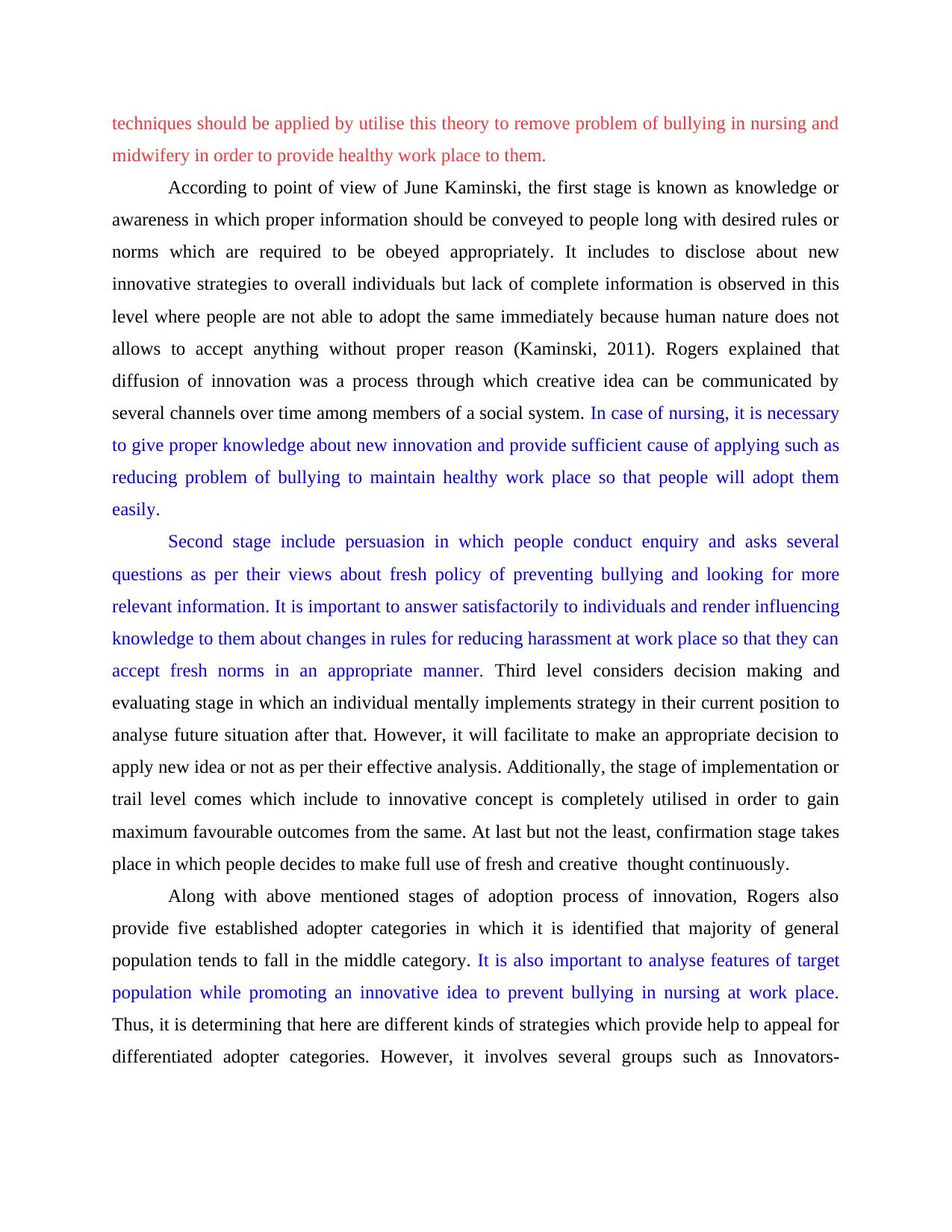
techniques should be applied by utilise this theory to remove problem of bullying in nursing and
midwifery in order to provide healthy work place to them.
According to point of view of June Kaminski, the first stage is known as knowledge or
awareness in which proper information should be conveyed to people long with desired rules or
norms which are required to be obeyed appropriately. It includes to disclose about new
innovative strategies to overall individuals but lack of complete information is observed in this
level where people are not able to adopt the same immediately because human nature does not
allows to accept anything without proper reason (Kaminski, 2011). Rogers explained that
diffusion of innovation was a process through which creative idea can be communicated by
several channels over time among members of a social system. In case of nursing, it is necessary
to give proper knowledge about new innovation and provide sufficient cause of applying such as
reducing problem of bullying to maintain healthy work place so that people will adopt them
easily.
Second stage include persuasion in which people conduct enquiry and asks several
questions as per their views about fresh policy of preventing bullying and looking for more
relevant information. It is important to answer satisfactorily to individuals and render influencing
knowledge to them about changes in rules for reducing harassment at work place so that they can
accept fresh norms in an appropriate manner. Third level considers decision making and
evaluating stage in which an individual mentally implements strategy in their current position to
analyse future situation after that. However, it will facilitate to make an appropriate decision to
apply new idea or not as per their effective analysis. Additionally, the stage of implementation or
trail level comes which include to innovative concept is completely utilised in order to gain
maximum favourable outcomes from the same. At last but not the least, confirmation stage takes
place in which people decides to make full use of fresh and creative thought continuously.
Along with above mentioned stages of adoption process of innovation, Rogers also
provide five established adopter categories in which it is identified that majority of general
population tends to fall in the middle category. It is also important to analyse features of target
population while promoting an innovative idea to prevent bullying in nursing at work place.
Thus, it is determining that here are different kinds of strategies which provide help to appeal for
differentiated adopter categories. However, it involves several groups such as Innovators-
midwifery in order to provide healthy work place to them.
According to point of view of June Kaminski, the first stage is known as knowledge or
awareness in which proper information should be conveyed to people long with desired rules or
norms which are required to be obeyed appropriately. It includes to disclose about new
innovative strategies to overall individuals but lack of complete information is observed in this
level where people are not able to adopt the same immediately because human nature does not
allows to accept anything without proper reason (Kaminski, 2011). Rogers explained that
diffusion of innovation was a process through which creative idea can be communicated by
several channels over time among members of a social system. In case of nursing, it is necessary
to give proper knowledge about new innovation and provide sufficient cause of applying such as
reducing problem of bullying to maintain healthy work place so that people will adopt them
easily.
Second stage include persuasion in which people conduct enquiry and asks several
questions as per their views about fresh policy of preventing bullying and looking for more
relevant information. It is important to answer satisfactorily to individuals and render influencing
knowledge to them about changes in rules for reducing harassment at work place so that they can
accept fresh norms in an appropriate manner. Third level considers decision making and
evaluating stage in which an individual mentally implements strategy in their current position to
analyse future situation after that. However, it will facilitate to make an appropriate decision to
apply new idea or not as per their effective analysis. Additionally, the stage of implementation or
trail level comes which include to innovative concept is completely utilised in order to gain
maximum favourable outcomes from the same. At last but not the least, confirmation stage takes
place in which people decides to make full use of fresh and creative thought continuously.
Along with above mentioned stages of adoption process of innovation, Rogers also
provide five established adopter categories in which it is identified that majority of general
population tends to fall in the middle category. It is also important to analyse features of target
population while promoting an innovative idea to prevent bullying in nursing at work place.
Thus, it is determining that here are different kinds of strategies which provide help to appeal for
differentiated adopter categories. However, it involves several groups such as Innovators-
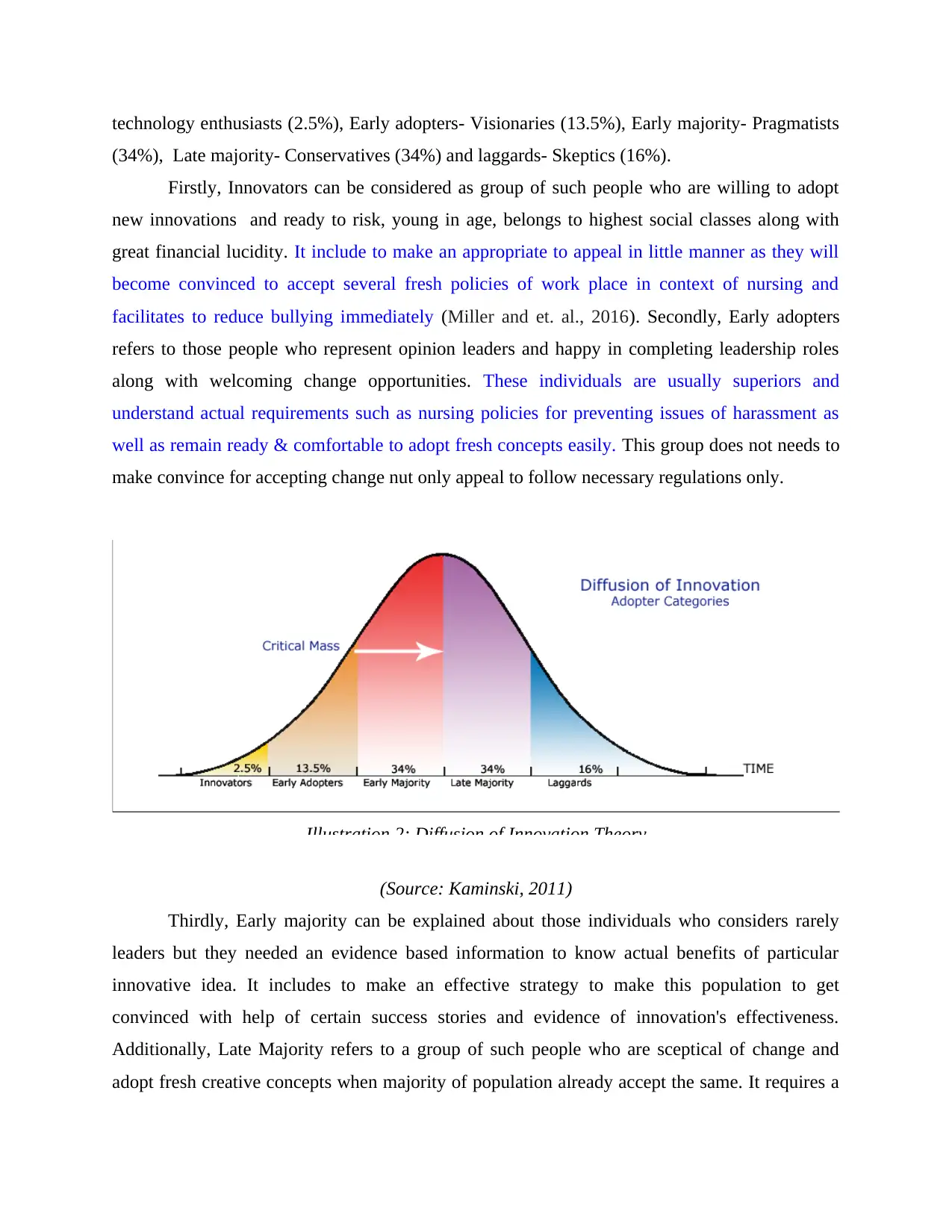
technology enthusiasts (2.5%), Early adopters- Visionaries (13.5%), Early majority- Pragmatists
(34%), Late majority- Conservatives (34%) and laggards- Skeptics (16%).
Firstly, Innovators can be considered as group of such people who are willing to adopt
new innovations and ready to risk, young in age, belongs to highest social classes along with
great financial lucidity. It include to make an appropriate to appeal in little manner as they will
become convinced to accept several fresh policies of work place in context of nursing and
facilitates to reduce bullying immediately (Miller and et. al., 2016). Secondly, Early adopters
refers to those people who represent opinion leaders and happy in completing leadership roles
along with welcoming change opportunities. These individuals are usually superiors and
understand actual requirements such as nursing policies for preventing issues of harassment as
well as remain ready & comfortable to adopt fresh concepts easily. This group does not needs to
make convince for accepting change nut only appeal to follow necessary regulations only.
(Source: Kaminski, 2011)
Thirdly, Early majority can be explained about those individuals who considers rarely
leaders but they needed an evidence based information to know actual benefits of particular
innovative idea. It includes to make an effective strategy to make this population to get
convinced with help of certain success stories and evidence of innovation's effectiveness.
Additionally, Late Majority refers to a group of such people who are sceptical of change and
adopt fresh creative concepts when majority of population already accept the same. It requires a
Illustration 2: Diffusion of Innovation Theory
(34%), Late majority- Conservatives (34%) and laggards- Skeptics (16%).
Firstly, Innovators can be considered as group of such people who are willing to adopt
new innovations and ready to risk, young in age, belongs to highest social classes along with
great financial lucidity. It include to make an appropriate to appeal in little manner as they will
become convinced to accept several fresh policies of work place in context of nursing and
facilitates to reduce bullying immediately (Miller and et. al., 2016). Secondly, Early adopters
refers to those people who represent opinion leaders and happy in completing leadership roles
along with welcoming change opportunities. These individuals are usually superiors and
understand actual requirements such as nursing policies for preventing issues of harassment as
well as remain ready & comfortable to adopt fresh concepts easily. This group does not needs to
make convince for accepting change nut only appeal to follow necessary regulations only.
(Source: Kaminski, 2011)
Thirdly, Early majority can be explained about those individuals who considers rarely
leaders but they needed an evidence based information to know actual benefits of particular
innovative idea. It includes to make an effective strategy to make this population to get
convinced with help of certain success stories and evidence of innovation's effectiveness.
Additionally, Late Majority refers to a group of such people who are sceptical of change and
adopt fresh creative concepts when majority of population already accept the same. It requires a
Illustration 2: Diffusion of Innovation Theory
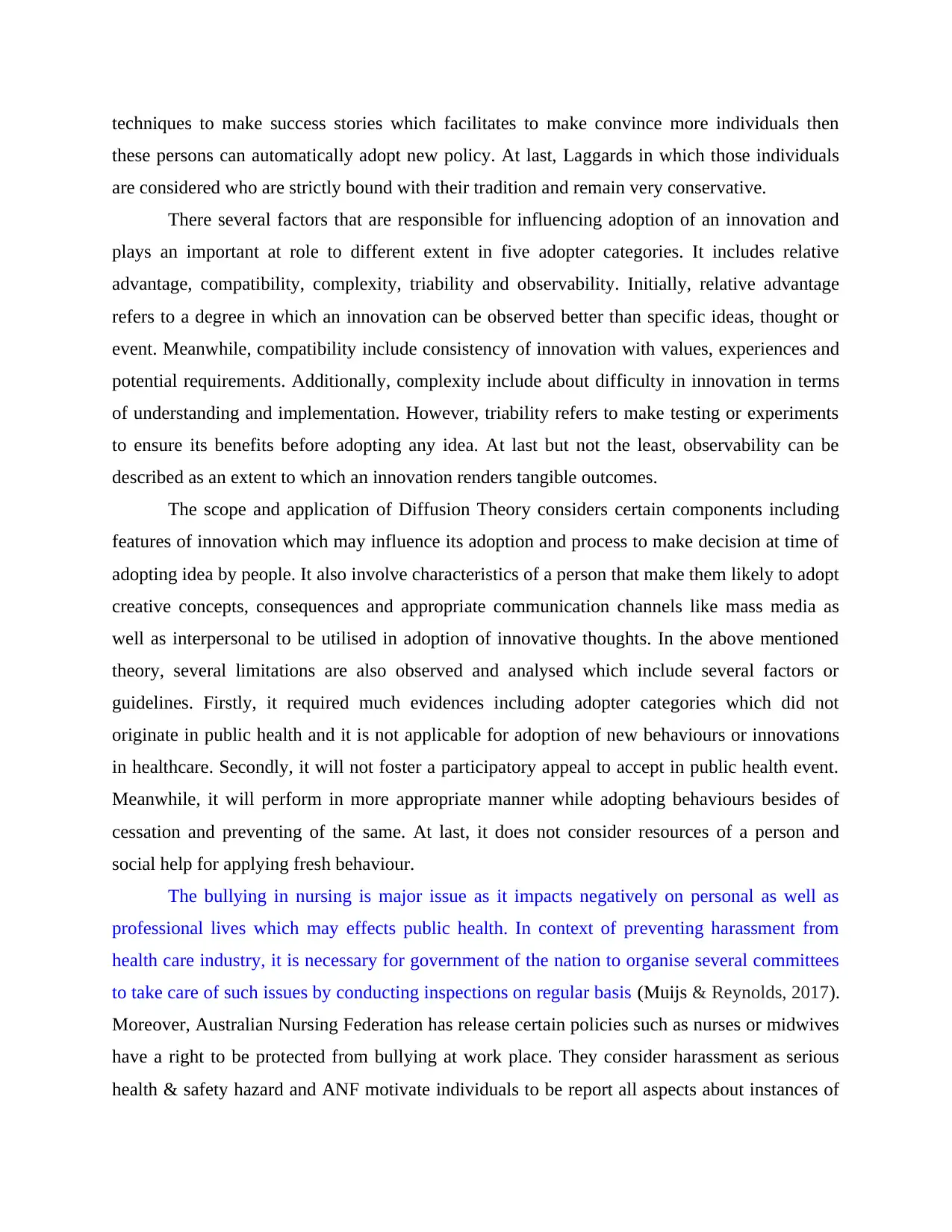
techniques to make success stories which facilitates to make convince more individuals then
these persons can automatically adopt new policy. At last, Laggards in which those individuals
are considered who are strictly bound with their tradition and remain very conservative.
There several factors that are responsible for influencing adoption of an innovation and
plays an important at role to different extent in five adopter categories. It includes relative
advantage, compatibility, complexity, triability and observability. Initially, relative advantage
refers to a degree in which an innovation can be observed better than specific ideas, thought or
event. Meanwhile, compatibility include consistency of innovation with values, experiences and
potential requirements. Additionally, complexity include about difficulty in innovation in terms
of understanding and implementation. However, triability refers to make testing or experiments
to ensure its benefits before adopting any idea. At last but not the least, observability can be
described as an extent to which an innovation renders tangible outcomes.
The scope and application of Diffusion Theory considers certain components including
features of innovation which may influence its adoption and process to make decision at time of
adopting idea by people. It also involve characteristics of a person that make them likely to adopt
creative concepts, consequences and appropriate communication channels like mass media as
well as interpersonal to be utilised in adoption of innovative thoughts. In the above mentioned
theory, several limitations are also observed and analysed which include several factors or
guidelines. Firstly, it required much evidences including adopter categories which did not
originate in public health and it is not applicable for adoption of new behaviours or innovations
in healthcare. Secondly, it will not foster a participatory appeal to accept in public health event.
Meanwhile, it will perform in more appropriate manner while adopting behaviours besides of
cessation and preventing of the same. At last, it does not consider resources of a person and
social help for applying fresh behaviour.
The bullying in nursing is major issue as it impacts negatively on personal as well as
professional lives which may effects public health. In context of preventing harassment from
health care industry, it is necessary for government of the nation to organise several committees
to take care of such issues by conducting inspections on regular basis (Muijs & Reynolds, 2017).
Moreover, Australian Nursing Federation has release certain policies such as nurses or midwives
have a right to be protected from bullying at work place. They consider harassment as serious
health & safety hazard and ANF motivate individuals to be report all aspects about instances of
these persons can automatically adopt new policy. At last, Laggards in which those individuals
are considered who are strictly bound with their tradition and remain very conservative.
There several factors that are responsible for influencing adoption of an innovation and
plays an important at role to different extent in five adopter categories. It includes relative
advantage, compatibility, complexity, triability and observability. Initially, relative advantage
refers to a degree in which an innovation can be observed better than specific ideas, thought or
event. Meanwhile, compatibility include consistency of innovation with values, experiences and
potential requirements. Additionally, complexity include about difficulty in innovation in terms
of understanding and implementation. However, triability refers to make testing or experiments
to ensure its benefits before adopting any idea. At last but not the least, observability can be
described as an extent to which an innovation renders tangible outcomes.
The scope and application of Diffusion Theory considers certain components including
features of innovation which may influence its adoption and process to make decision at time of
adopting idea by people. It also involve characteristics of a person that make them likely to adopt
creative concepts, consequences and appropriate communication channels like mass media as
well as interpersonal to be utilised in adoption of innovative thoughts. In the above mentioned
theory, several limitations are also observed and analysed which include several factors or
guidelines. Firstly, it required much evidences including adopter categories which did not
originate in public health and it is not applicable for adoption of new behaviours or innovations
in healthcare. Secondly, it will not foster a participatory appeal to accept in public health event.
Meanwhile, it will perform in more appropriate manner while adopting behaviours besides of
cessation and preventing of the same. At last, it does not consider resources of a person and
social help for applying fresh behaviour.
The bullying in nursing is major issue as it impacts negatively on personal as well as
professional lives which may effects public health. In context of preventing harassment from
health care industry, it is necessary for government of the nation to organise several committees
to take care of such issues by conducting inspections on regular basis (Muijs & Reynolds, 2017).
Moreover, Australian Nursing Federation has release certain policies such as nurses or midwives
have a right to be protected from bullying at work place. They consider harassment as serious
health & safety hazard and ANF motivate individuals to be report all aspects about instances of
Secure Best Marks with AI Grader
Need help grading? Try our AI Grader for instant feedback on your assignments.
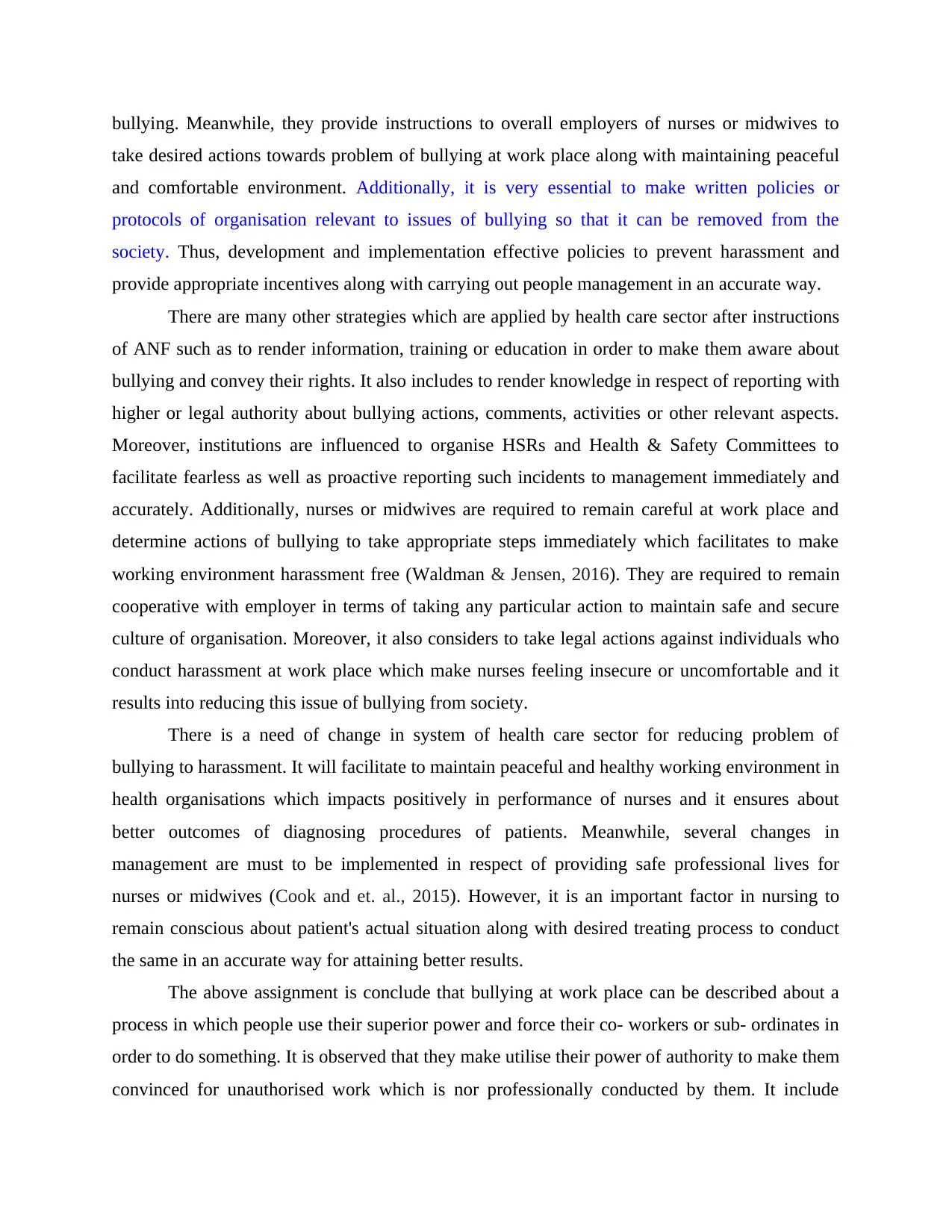
bullying. Meanwhile, they provide instructions to overall employers of nurses or midwives to
take desired actions towards problem of bullying at work place along with maintaining peaceful
and comfortable environment. Additionally, it is very essential to make written policies or
protocols of organisation relevant to issues of bullying so that it can be removed from the
society. Thus, development and implementation effective policies to prevent harassment and
provide appropriate incentives along with carrying out people management in an accurate way.
There are many other strategies which are applied by health care sector after instructions
of ANF such as to render information, training or education in order to make them aware about
bullying and convey their rights. It also includes to render knowledge in respect of reporting with
higher or legal authority about bullying actions, comments, activities or other relevant aspects.
Moreover, institutions are influenced to organise HSRs and Health & Safety Committees to
facilitate fearless as well as proactive reporting such incidents to management immediately and
accurately. Additionally, nurses or midwives are required to remain careful at work place and
determine actions of bullying to take appropriate steps immediately which facilitates to make
working environment harassment free (Waldman & Jensen, 2016). They are required to remain
cooperative with employer in terms of taking any particular action to maintain safe and secure
culture of organisation. Moreover, it also considers to take legal actions against individuals who
conduct harassment at work place which make nurses feeling insecure or uncomfortable and it
results into reducing this issue of bullying from society.
There is a need of change in system of health care sector for reducing problem of
bullying to harassment. It will facilitate to maintain peaceful and healthy working environment in
health organisations which impacts positively in performance of nurses and it ensures about
better outcomes of diagnosing procedures of patients. Meanwhile, several changes in
management are must to be implemented in respect of providing safe professional lives for
nurses or midwives (Cook and et. al., 2015). However, it is an important factor in nursing to
remain conscious about patient's actual situation along with desired treating process to conduct
the same in an accurate way for attaining better results.
The above assignment is conclude that bullying at work place can be described about a
process in which people use their superior power and force their co- workers or sub- ordinates in
order to do something. It is observed that they make utilise their power of authority to make them
convinced for unauthorised work which is nor professionally conducted by them. It include
take desired actions towards problem of bullying at work place along with maintaining peaceful
and comfortable environment. Additionally, it is very essential to make written policies or
protocols of organisation relevant to issues of bullying so that it can be removed from the
society. Thus, development and implementation effective policies to prevent harassment and
provide appropriate incentives along with carrying out people management in an accurate way.
There are many other strategies which are applied by health care sector after instructions
of ANF such as to render information, training or education in order to make them aware about
bullying and convey their rights. It also includes to render knowledge in respect of reporting with
higher or legal authority about bullying actions, comments, activities or other relevant aspects.
Moreover, institutions are influenced to organise HSRs and Health & Safety Committees to
facilitate fearless as well as proactive reporting such incidents to management immediately and
accurately. Additionally, nurses or midwives are required to remain careful at work place and
determine actions of bullying to take appropriate steps immediately which facilitates to make
working environment harassment free (Waldman & Jensen, 2016). They are required to remain
cooperative with employer in terms of taking any particular action to maintain safe and secure
culture of organisation. Moreover, it also considers to take legal actions against individuals who
conduct harassment at work place which make nurses feeling insecure or uncomfortable and it
results into reducing this issue of bullying from society.
There is a need of change in system of health care sector for reducing problem of
bullying to harassment. It will facilitate to maintain peaceful and healthy working environment in
health organisations which impacts positively in performance of nurses and it ensures about
better outcomes of diagnosing procedures of patients. Meanwhile, several changes in
management are must to be implemented in respect of providing safe professional lives for
nurses or midwives (Cook and et. al., 2015). However, it is an important factor in nursing to
remain conscious about patient's actual situation along with desired treating process to conduct
the same in an accurate way for attaining better results.
The above assignment is conclude that bullying at work place can be described about a
process in which people use their superior power and force their co- workers or sub- ordinates in
order to do something. It is observed that they make utilise their power of authority to make them
convinced for unauthorised work which is nor professionally conducted by them. It include
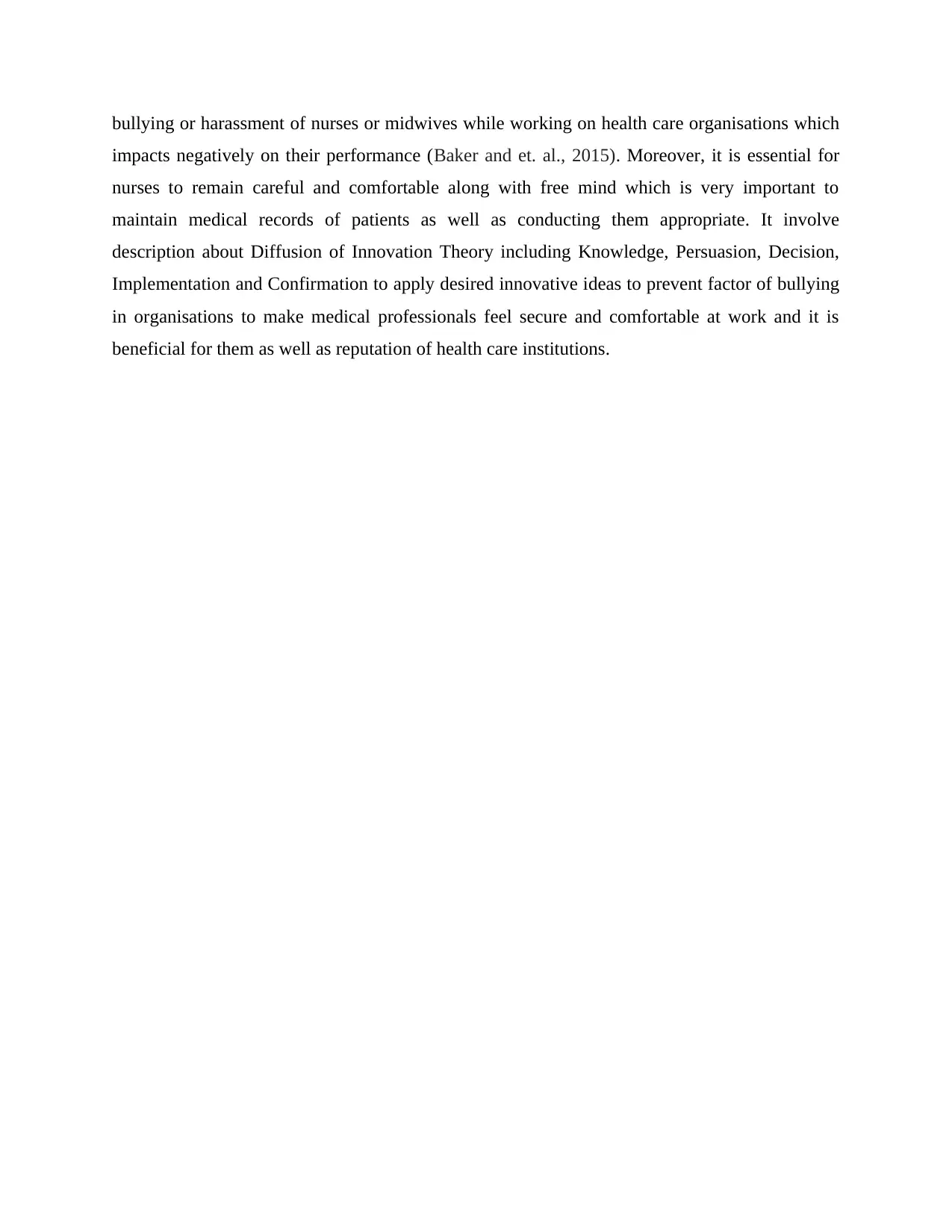
bullying or harassment of nurses or midwives while working on health care organisations which
impacts negatively on their performance (Baker and et. al., 2015). Moreover, it is essential for
nurses to remain careful and comfortable along with free mind which is very important to
maintain medical records of patients as well as conducting them appropriate. It involve
description about Diffusion of Innovation Theory including Knowledge, Persuasion, Decision,
Implementation and Confirmation to apply desired innovative ideas to prevent factor of bullying
in organisations to make medical professionals feel secure and comfortable at work and it is
beneficial for them as well as reputation of health care institutions.
impacts negatively on their performance (Baker and et. al., 2015). Moreover, it is essential for
nurses to remain careful and comfortable along with free mind which is very important to
maintain medical records of patients as well as conducting them appropriate. It involve
description about Diffusion of Innovation Theory including Knowledge, Persuasion, Decision,
Implementation and Confirmation to apply desired innovative ideas to prevent factor of bullying
in organisations to make medical professionals feel secure and comfortable at work and it is
beneficial for them as well as reputation of health care institutions.
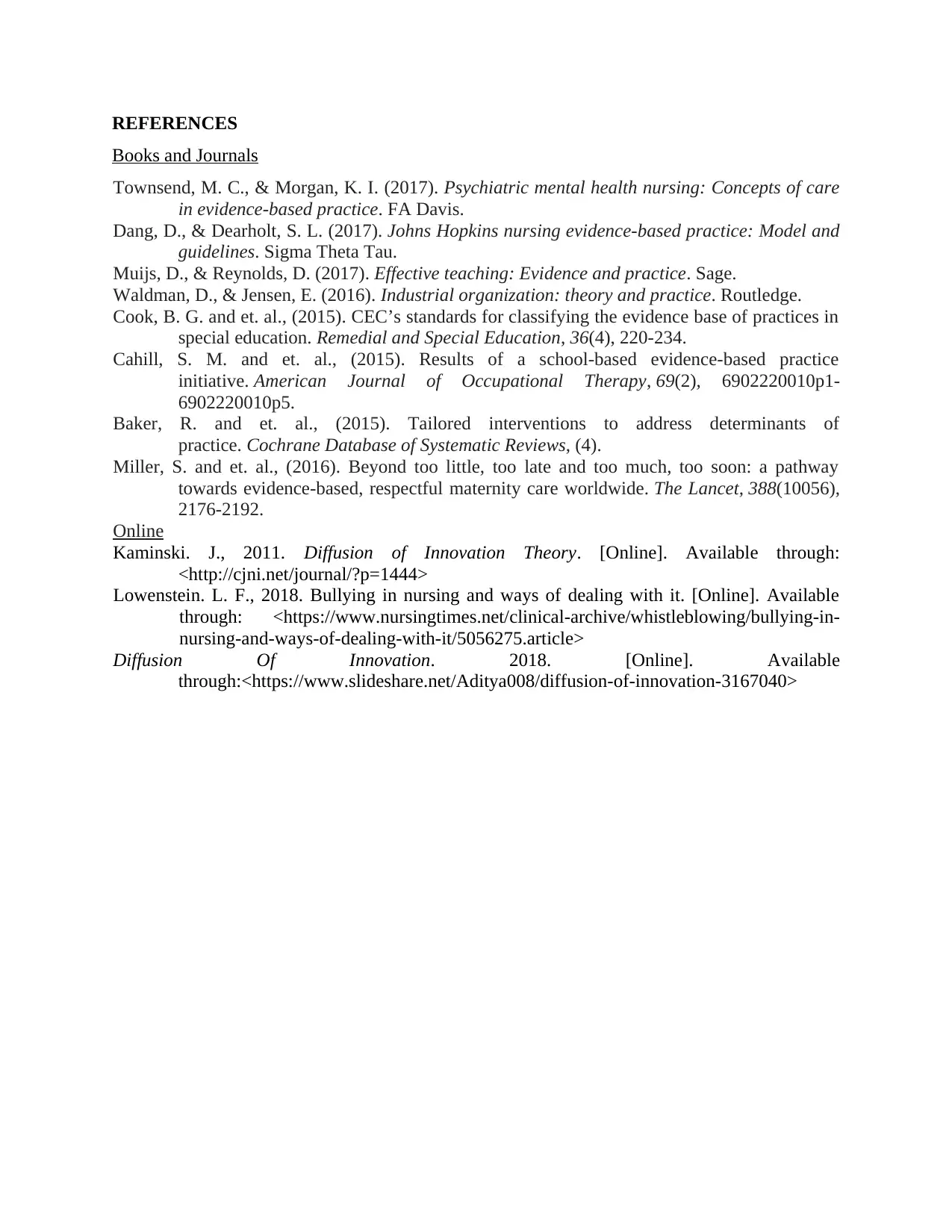
REFERENCES
Books and Journals
Townsend, M. C., & Morgan, K. I. (2017). Psychiatric mental health nursing: Concepts of care
in evidence-based practice. FA Davis.
Dang, D., & Dearholt, S. L. (2017). Johns Hopkins nursing evidence-based practice: Model and
guidelines. Sigma Theta Tau.
Muijs, D., & Reynolds, D. (2017). Effective teaching: Evidence and practice. Sage.
Waldman, D., & Jensen, E. (2016). Industrial organization: theory and practice. Routledge.
Cook, B. G. and et. al., (2015). CEC’s standards for classifying the evidence base of practices in
special education. Remedial and Special Education, 36(4), 220-234.
Cahill, S. M. and et. al., (2015). Results of a school-based evidence-based practice
initiative. American Journal of Occupational Therapy, 69(2), 6902220010p1-
6902220010p5.
Baker, R. and et. al., (2015). Tailored interventions to address determinants of
practice. Cochrane Database of Systematic Reviews, (4).
Miller, S. and et. al., (2016). Beyond too little, too late and too much, too soon: a pathway
towards evidence-based, respectful maternity care worldwide. The Lancet, 388(10056),
2176-2192.
Online
Kaminski. J., 2011. Diffusion of Innovation Theory. [Online]. Available through:
<http://cjni.net/journal/?p=1444>
Lowenstein. L. F., 2018. Bullying in nursing and ways of dealing with it. [Online]. Available
through: <https://www.nursingtimes.net/clinical-archive/whistleblowing/bullying-in-
nursing-and-ways-of-dealing-with-it/5056275.article>
Diffusion Of Innovation. 2018. [Online]. Available
through:<https://www.slideshare.net/Aditya008/diffusion-of-innovation-3167040>
Books and Journals
Townsend, M. C., & Morgan, K. I. (2017). Psychiatric mental health nursing: Concepts of care
in evidence-based practice. FA Davis.
Dang, D., & Dearholt, S. L. (2017). Johns Hopkins nursing evidence-based practice: Model and
guidelines. Sigma Theta Tau.
Muijs, D., & Reynolds, D. (2017). Effective teaching: Evidence and practice. Sage.
Waldman, D., & Jensen, E. (2016). Industrial organization: theory and practice. Routledge.
Cook, B. G. and et. al., (2015). CEC’s standards for classifying the evidence base of practices in
special education. Remedial and Special Education, 36(4), 220-234.
Cahill, S. M. and et. al., (2015). Results of a school-based evidence-based practice
initiative. American Journal of Occupational Therapy, 69(2), 6902220010p1-
6902220010p5.
Baker, R. and et. al., (2015). Tailored interventions to address determinants of
practice. Cochrane Database of Systematic Reviews, (4).
Miller, S. and et. al., (2016). Beyond too little, too late and too much, too soon: a pathway
towards evidence-based, respectful maternity care worldwide. The Lancet, 388(10056),
2176-2192.
Online
Kaminski. J., 2011. Diffusion of Innovation Theory. [Online]. Available through:
<http://cjni.net/journal/?p=1444>
Lowenstein. L. F., 2018. Bullying in nursing and ways of dealing with it. [Online]. Available
through: <https://www.nursingtimes.net/clinical-archive/whistleblowing/bullying-in-
nursing-and-ways-of-dealing-with-it/5056275.article>
Diffusion Of Innovation. 2018. [Online]. Available
through:<https://www.slideshare.net/Aditya008/diffusion-of-innovation-3167040>
1 out of 10
Your All-in-One AI-Powered Toolkit for Academic Success.
+13062052269
info@desklib.com
Available 24*7 on WhatsApp / Email
![[object Object]](/_next/static/media/star-bottom.7253800d.svg)
Unlock your academic potential
© 2024 | Zucol Services PVT LTD | All rights reserved.
